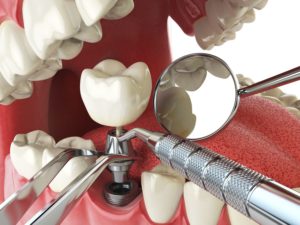Dental implants offer the most comprehensive benefits of the tooth replacement solutions your dentist can provide. They offer the longest-lasting method of securing prosthetic teeth in the mouth, whether you want to replace one, several, or an entire arch of missing teeth. This way, you can see a restoration of the appearance, function, and health of your smile with confidence.
Consult with your dentist to learn if you qualify for implant dentistry tooth replacement. This dental fixture works so well because of the multi-step process that ensures such a secure and trustworthy fit. Read on to learn more about the three parts of a dental implant.

Anchor
The anchor of a dental implant functions as the base of the fixture. Often made from titanium, this post is surgically placed into the jaw. Your dentist can give you one or more of these, depending on the type of implant you require to restore your smile.
As you heal from this procedure, the anchor fuses with the jawbone. This establishes a secure and permanent foundation that will support the rest of the implant above the gumline. You can trust this sturdy and stable component to give you restorative dental benefits that can last a lifetime. It serves as a replacement for the missing tooth root too.
The treatment relies on the fusion of the anchor with the jawbone. So you will require healthy, strong bone in the jaw to receive this treatment or the implant may fail. Your dentist will evaluate your jawbone health with x-ray imaging before beginning this process to ensure you qualify.
Abutment
Healing from the anchor placement procedure may take three or more months. Then your dentist will place an abutment over the anchor. The abutment refers to a small part of the dental implant atop the anchor that will serve as an attachment base connecting the anchor and the prosthetic teeth.
This portion of the implant ensures a comfortable as well as more secure fit for your implants. Though this process seems lengthy, you can feel confident that your final results will be worth it.
Prosthetic Teeth
After you recover from the anchor placement and the abutment is in place, your dentist can secure your prosthetic teeth into place to complete the implant dentistry process. These can come in the form of a crown, a bridge, or a denture, depending on how many teeth you intend to replace.
Your dentist builds prosthetic teeth on a customized basis for each of their patients, so you can receive a gorgeous and natural-looking finish that will suit your unique smile. The devices will fit the size, shape, and color of your smile according to your aesthetic and restorative goals.
The prosthetic teeth will resist both staining and decay so that you can enjoy the cosmetic effects of this treatment for twenty years or longer. You will still need to practice oral hygiene to keep your smile healthy. But dental implants do not need extra care to maintain.
